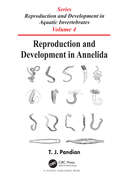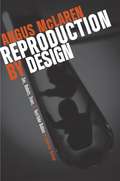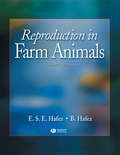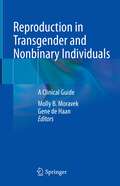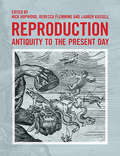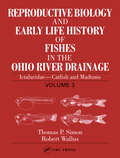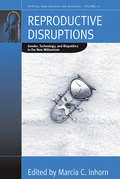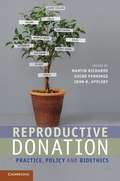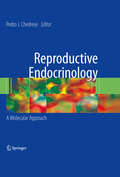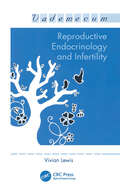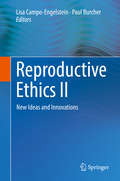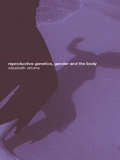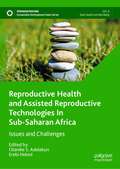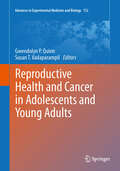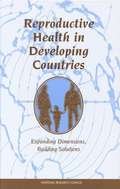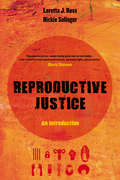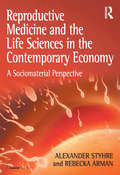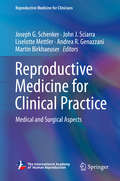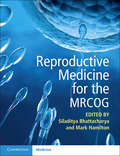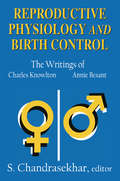- Table View
- List View
Reproduction and Development in Annelida (Reproduction and Development in Aquatic Invertebrates)
by T. J. PandianThis book is a concise informative elucidation of all aspects of reproduction and development in annelids covering from arenicola to tubifex. Annelids flourish between 4,900 m depth to 2,000 m altitude; some of them occur in unusual habitats like hydrothermal vents and subterranean aquatic system (stigobionts). A few have no gut and acquire adequate nutrients through osmotrophism and/or engaging symbiotic microbes. In the absence of exoskeleton to escape predation, the 17,000 speciose annelids have explored bewildering modes of reproduction; not surprisingly, 42–47% of them are brooders. With 13,000 species, polychaetes are gonochores but some 207 species of them are hermaphrodites. Clitellates are all hermaphrodites; of them, 76 species are parthenogens, of which 56 are earthworms. Regenerative potency of annelids ranges from an organ to an entire worm from a single ‘seminal’ segment. The head, tail and both together can be regenerated 21, 42 and 20 times, respectively. However, the potency is limited to ~1% of polychaetes and Heterogamatic sex determination is reported to occur only in six polychaete species, although karyotype is known for 83 annelid species. In temperate polychaetes, a dozen neuroendocrines, arising mostly from the ‘brain’ regulates reproductive cycle. A complete chapter devoted to vermiculture, (i) recognizes the fast-growing candidate species, (ii) distinguishes 'layers' from 'brooders', (iii) indicates that the harvest of oligochaetes may reduce the input of nitrogenous fertilizer in the ricefield, and (iv) explores the scope for increasing wealth from waste.
Reproduction and the Maternal Body in Literature and Culture: Bodies of Knowledge, 1726-1818 (Routledge Advances in the Medical Humanities)
by Jennifer S. HenkeThis book examines a selection of texts to discuss how midwifery, obstetrics and women’s bodies were constructed during the (long) eighteenth century, and how these material-discursive entanglements between science, medicine, literature and culture have shaped society's views of pregnancy, childbirth and reproduction.Drawing on theories from disciplines such as feminist new materialism, this book traces the history of both the reproductive body and the pluralistic medical knowledges that attended to pregnancy and childbirth during the Enlightenment and early Romanticism in Britain. It identifies the significance of literary and cultural artefacts in this knowledge formation, including the materiality of the female reproductive body itself, and raises awareness of myths about pregnancy and childbirth that persist today. This book features chapters exploring Jonathan Swift’s Gulliver’s Travels, John Cleland’s Fanny Hill, Laurence Sterne’s Tristram Shandy, Eliza Fenwick’s Secresy, Or: The Ruin on the Rock, Mary Wollstonecraft’s Maria, Or: The Wrongs of Woman, and Mary Shelley’s Frankenstein.Reproduction and the Maternal Body in Literature and Culture is an innovative and interdisciplinary contribution to the medical humanities and feminist philosophy of science and will interest scholars from a range of backgrounds, including literature and cultural studies, midwifery, medicine and history.
Reproduction by Design: Sex, Robots, Trees, and Test-Tube Babies in Interwar Britain
by Angus MclarenModernity in interwar Europe frequently took the form of a preoccupation with mechanizing the natural; fears and fantasies revolved around the notion that the boundaries between people and machines were collapsing. Reproduction in particular became a battleground for those debating the merits of the modern world. That debate continues today, and to understand the history of our anxieties about modernity, we can have no better guide than Angus McLaren. In Reproduction by Design, McLaren draws on novels, plays, science fiction, and films of the 1920s and '30s, as well as the work of biologists, psychiatrists, and sexologists, to reveal surprisingly early debates on many of the same questions that shape the conversation today: homosexuality, recreational sex, contraception, abortion, euthanasia, sex change operations, and in vitro fertilization. Here, McLaren brings together the experience and perception of modernity with sexuality, technology, and ecological concerns into a cogent discussion of science's place in reproduction in British and American cultural history.
Reproduction in Farm Animals
by B. Hafez E.S.E. HafezWhen you’re looking for a comprehensive and reliable text on large animal reproduction, look no further! the seventh edition of this classic text is geared for the undergraduate student in Agricultural Sciences and Veterinary Medicine. In response to reader feedback, Dr. Hafez has streamlined and edited the entire text to remove all repetitious and nonessential material. That means you'll learn more in fewer pages. Plus the seventh editing is filled with features that help you grasp the concepts of reproduction in farm animals so you'll perform better on exams and in practice: condensed and simplified tables, so they're easier to consult an easy-to-scan glossary at the end of the book an expanded appendix, which includes graphic illustrations of assisted reproduction technology Plus, you'll find valuable NEW COVERAGE on all these topics: Equine Reproduction: expanded information reflecting today's knowledge Llamas (NEW CHAPTER) Micromanipulation of Gametes and In Vitro Fertilization (NEW CHAPTER!) Reach for the text that's revised with the undergraduate in mind: the seventh edition of Hafez's Reproduction in Farm Animals.
Reproduction in Transgender and Nonbinary Individuals: A Clinical Guide
by Molly B. Moravek Gene De Haan<p>There are approximately 1.4 million trans-identified individuals in the US alone, many of whom will undergo gender-affirming medical or surgical interventions to better align their appearance with their gender identity. Multiple major medical societies recommend fertility preservation counseling prior to starting any gender-affirming therapies, but data are limited on the reproductive effects of common gender-affirming hormone regimens. The burden of fertility counseling falls to the hormone providers and surgeons that are encountering these patients, many of whom will not have had adequate training or resources to provide evidence-based recommendations and options. Additionally, many reproductive health care providers are not trained in how to care for gender minorities.<p> <p>The purpose of this book is to be a reference for clinicians and researchers in the field of transgender medicine, to provide up-to-date data and resources to properly counsel transgender and nonbinary patients about the reproductive consequences of gender-affirming interventions and their options for family-building, and to educate providers about appropriate and culturally competent reproductive health care. Effects of masculinizing and feminizing hormone therapy, as well as the fertility preservation options available, are discussed in detail for both adults and youth. In addition to these medical considerations, both psychosocial, legal and ethical considerations are highlighted for a more well-rounded presentation. A final chapter describes how to create a welcome and accepting clinical environment.<p> <p>Such a reference does not currently exist, leading to the propagation of misinformation and encouraging patients to seek nonmedical sources, such as social media, for their information. Reproduction in Transgender and Nonbinary Individuals fills in this gap as a timely text for reproductive endocrinologists, surgeons and all clinical staff working with this population.<p>
Reproduction, Globalization, and the State: New Theoretical and Ethnographic Perspectives
by Carole H. Browner Carolyn F. SargentReproduction, Globalization, and the State conceptualizes and puts into practice a global anthropology of reproduction and reproductive health. Leading anthropologists offer new perspectives on how transnational migration and global flows of communications, commodities, and biotechnologies affect the reproductive lives of women and men in diverse societies throughout the world. Based on research in Africa, the Americas, Asia, and Western Europe, their fascinating ethnographies provide insight into reproduction and reproductive health broadly conceived to encompass population control, HIV/AIDS, assisted reproductive technologies, paternity tests, sex work, and humanitarian assistance. The contributors address the methodological challenges of research on globalization, including ways of combining fine-grained ethnography with analyses of large-scale political, economic, and ideological forces. Their essays reveal complex interactions among global and state population policies and politics; public health, human rights, and feminist movements; diverse medical systems; various religious practices, doctrines, and institutions; and intimate relationships and individual aspirations. Contributors. Aditya Bharadwaj, Caroline H. Bledsoe, Carole H. Browner, Junjie Chen, Aimee R. Eden, Susan L. Erikson, Didier Fassin, Claudia Lee Williams Fonseca, Ellen Gruenbaum, Matthew Gutmann, Marcia C. Inhorn, Mark B. Padilla, Rayna Rapp, Lisa Ann Richey, Carolyn Sargent, Papa Sow, Cecilia Van Hollen, Linda Whiteford
Reproduction: Antiquity to the Present Day
by Nick Hopwood Rebecca Flemming Lauren KassellFrom contraception to cloning and pregnancy to populations, reproduction presents urgent challenges today. This field-defining history synthesizes a vast amount of scholarship to take the long view. Spanning from antiquity to the present day, the book focuses on the Mediterranean, western Europe, North America and their empires. It combines history of science, technology and medicine with social, cultural and demographic accounts. Ranging from the most intimate experiences to planetary policy, it tells new stories and revises received ideas. An international team of scholars asks how modern 'reproduction' - an abstract process of perpetuating living organisms - replaced the old 'generation' - the active making of humans and beasts, plants and even minerals. Striking illustrations invite readers to explore artefacts, from an ancient Egyptian fertility figurine to the announcement of the first test-tube baby. Authoritative and accessible, Reproduction offers students and non-specialists an essential starting point and sets fresh agendas for research.
Reproductive Biology and Early Life History of Fishes in the Ohio River Drainage: Ictaluridae - Catfish and Madtoms, Volume 3
by Thomas P. Simon Robert WallusThis series fills immense gaps in knowledge of issues related to early life development of fishes in the Ohio basin. Volume III addresses the developmental and morphological issues of catfish and madtoms. This volume describes the characteristics of the Ictaluridae family, and provides a detailed pictorial guide. Subtopics within each species description includes range, distribution, occurrence, spawning, eggs, development, ecology of early life phases, and more. This book serves as both a guide to help identify individual larval fish and as a reference for environmental managers concerned with the overall health of the ecosystem that they are monitoring.
Reproductive Citizenship: Technologies, Rights and Relationships (Health, Technology and Society)
by Rhonda M. ShawThis book addresses responses to the predicament of medical and social infertility. It draws on international research to examine the dimensions of reproductive citizenship in relation to decision-making about a range of issues: from fertility preservation and the desirability of family creation as a normative expectation of social participation, to how families manage and negotiate engagement with providers of reproductive materials and services around information disclosure and contact, and how they consider their social obligations and responsibilities in relation to the use of assisted reproductive technology (ART).
Reproductive Disruptions
by Marcia C. InhornNominated for the 2007 Book Prize by the Council on Anthropology and Reproduction (AAA) Reproductive disruptions, such as infertility, pregnancy loss, adoption, and childhood disability, are among the most distressing experiences in people's lives. Based on research by leading medical anthropologists from around the world, this book examines such issues as local practices detrimental to safe pregnancy and birth; conflicting reproductive goals between women and men; miscommunications between pregnant women and their genetic counselors; cultural anxieties over gamete donation and adoption; the contested meanings of abortion; cultural critiques of hormone replacement therapy; and the globalization of new pharmaceutical and assisted reproductive technologies. This breadth - with its explicit move from the "local" to the "global," from the realm of everyday reproductive practice to international programs and policies - illuminates most effectively the workings of power, the tensions between women's and men's reproductive agency, and various cultural and structural inequalities in reproductive health.
Reproductive Donation
by Martin Richards Guido Pennings John B. ApplebyReproductive donation is the most contentious area of assisted reproduction. Even within Europe there are wide variations in what is permitted in each country. This multidisciplinary book takes a fresh look at the practices of egg, sperm and embryo donation and surrogacy, bringing together ethical analysis and empirical research. New evidence is offered on aspects of assisted reproduction and the families these create, including non-traditional types. One of the key issues addressed is should children be told of their donor origin? If they do learn the identity of their donor, what kinds of relationships may be forged between families, the donor and other donor sibling families? Should donation involve a gift relationship? Is intra-familial donation too close for comfort? How should we understand the growing trend for 'reproductive tourism'? This lively and informed discussion offers new insights into reproductive donation and the resulting donor families.
Reproductive Endocrinology
by P. Jorge ChedreseMolecular biology emerged from advances in biochemistry during the 1940s and 1950s, when the structure of the nucleic acids and proteins were elucidated. Beginning in the 1970s, with nucleic acid enzymology and the discovery of the restriction enzymes, the tools of molecular biology became widely available and applied in cell biology to study how genes are regulated. This new knowledge impacted endocrinology and reproductive biology since it was largely known that the secretion of the internal glands affected the phenotypes, and expression of genes. Modern reproductive biology encompasses every level of biological study from genomics to ecology, encompassing cell biology, biochemistry, endocrinology and general physiology. All of these disciplines require a basic knowledge, both as a tool and as an essential aid to a fundamental understanding of the principles of life in health and disease. Overall, molecular biology is central to scientific studies in all living matter, impacting disciplines such as medicine, related health sciences, veterinary, agriculture and environmental sciences. In this book, the basic biochemistry of nucleic acids and proteins are reviewed. Methodologies used to study signaling and gene regulation in the endocrine/reproductive system are also discussed. Topics include mechanisms of hormone action and several endocrine disorders affecting the reproductive system. Professionals in the medical, veterinary and animal sciences fields will find exciting and stimulating material enhancing the breadth and quality of their research.
Reproductive Endocrinology and Infertility
by Douglas T. Carrell C. Matthew PetersonManagement of the modern reproductive endocrinology and infertility clinic has become very complex. In addition to the medical and scientific aspects, it is crucial that the modern director be aware of of incongruent fields such as marketing, accounting, management, and regulatory issues. Reproductive Endocrinology and Infertility: Integrating Modern Clinical and Laboratory Practice was developed to assist the practicing reproductive endocrinologist and/or laboratory director by providing an overview of relevant scientific, medical, and management issues in a single volume. Experts in all pertinent areas present concise, practical, evidence-based summaries of relevant topics, producing a key resource for physicians and scientists engaged in this exciting field of medicine. As novel technologies continue to amplify, Reproductive Endocrinology and Infertility: Integrating Modern Clinical and Laboratory Practice offers insight into development, and imparts extra confidence to practitioners in handling the many demands presented by their work.
Reproductive Endocrinology and Infertility
by Dr. Vivian LewisReproductive Endocrinology and Infertility provides an overview of the most frequently encountered clinical challenges faced by medical students and residents. Part I begins with chapters on reproductive hormonal physiology and development to provide a basis for understanding the management of the most common reproductive clinical problems that confront obstetrician-gynecologists and other practitioners in women’s health. Several of the chapters, including obesity, premenstrual syndrome, menopause and imaging, provide a cross-disciplinary approach to endocrine related problems common among reproductive aged women. Part II includes chapters on the evaluation of infertility, as well as surgical and medical approaches to treating infertility in men and women. The chapter on alternative medicine provides a basis for understanding the increasingly popular use of therapies such as acupuncture and herbal treatments. The last chapter discusses the influence of environmental factors on fertility, an important field that is often ignored in the traditional approach to infertility.This text is meant to be used as a portable reference with readily accessible information including a summary of key points in each chapter. All of the contributors are involved in residency training programs and understand the kinds of patient management questions that are encountered in a busy practice. Our goal with this book is to provide information that will support solid patient management and hopefully pique the appetite to learn more.
Reproductive Ethics II: New Ideas and Innovations
by Lisa Campo-Engelstein Paul BurcherThis book is the second collection of essays on reproductive ethics from Drs. Campo-Engelstein and Burcher. This volume is unique in that it is both timely and includes several essays on new technologies, while also being a comprehensive review of most of the major questions in the field, from racial disparities in reproductive healthcare to gene editing and the possibility of the creation of a transhuman species. The scholars writing these essays are pre-eminent in their fields, and their backgrounds are quite varied, including philosophers, anthropologists, physicians, and professors of law. Reproductive ethics remains an underdeveloped area of bioethics despite the recent technological breakthroughs that carry both great promise and potential threats. Building on the first volume of work from a conference held just over one year ago, this new collection of essays from a conference held April 2017 continues this discussion as well as provides ethical insights and reviews of these emerging technologies. The ethical questions swirling around human reproduction are both old and new, but the conference presentations, and the essays derived from them, focus on new ways of appreciating old arguments such as the ethics of abortion, as well as new ways of seeing new technologies such as CRISPR and mitochondrial transfer.
Reproductive Genetics
by Sean Kehoe Lyn Chitty Tessa HomfrayThis is a unique book, covering areas not available elsewhere. Within its pages, the authors discuss many diverse areas relating to reproduction and genetics. Great progress has been made in the field of genetics within the past decade. This, combined with our growing knowledge, has impacted on this important area with interesting consequences. The ability to identify genetic defects before implantation, to diagnose fetal abnormalities and to introduce screening programmes means that genetic testing now has a major role in preventive medicine. These topics are discussed in detail in the book. In parallel with these advances, other aspects that cannot be ignored, such as education of the public and the potential ethical dilemmas that may arise by virtue of these new methodologies, are raised and discussed in this volume, which is based on the 57th RCOG Study Group and includes a set of consensus views from the expert participants. This book provides topical and essential information for practising clinicians, researchers and other healthcare professionals interested in these fields of study.
Reproductive Genetics, Gender and the Body
by Elizabeth EttorreThis book is all about reproductive genetics, a sociological concept developed to define the use of DNA-based technologies in the medical management and supervision of reproduction and pregnant women. In a searching analysis, Elizabeth Ettorre uncovers the hidden social processes involved in the development of these technologies. Focussing on prenatal screening, she explores how the key concepts of gender and the body are intertwined with the process of building genetic knowledge and some of the unintended consequences for women. These include the injection of biology into social relationships and the development of a gendered discourse of shame and stigmatisation in which the perfect body becomes idealised and new conceptions of disability are shaped. It becomes clear that the modernist tradition of scientific disinterestedness is being replaced by a new ethic: the making of moral judgements by scientists. Reproductive Genetics, Gender and the Body draws on interviews with European medical, legal and nursing professionals and raises important issues around the gendered, female body, the site of genetic capital. It challenges professional and scholar alike to grapple with and think through their responsibilities in this complex field where the competing issues have yet to be resolved.
Reproductive Health and Assisted Reproductive Technologies In Sub-Saharan Africa: Issues and Challenges (Sustainable Development Goals Series)
by Olanike S. Adelakun Erebi NdoniThis book focuses on reproductive health rights and assisted reproductive technologies (ART) in sub-Saharan Africa. Each chapter is connected to the other by focusing on different aspects of ART as a means of achieving conception.Topics such as regulation of ART practices, surrogacy and specific aspects of ART, which are gradually becoming acceptable but largely unregulated in Africa, promises to be of interest to scholars, researchers and fertility practitioners. Research in the book take a rights based approach and ethical analysis of ART practice in sub-Saharan Africa by authors from diverse backgrounds bringing together law and society perspectives.Readers stand to gain new knowledge on the societal, legal, medical and psychological requirements, effects and challenges of reproductive health rights and ART in the African context. The book is also relevant to UN Sustainable Development Goal 3: Good Health and Well-being, given that it promotes and advocates for access to reproductive healthcare for persons who have difficulty or are unable to conceive without medical assistance.
Reproductive Health and Cancer in Adolescents and Young Adults
by Gwendolyn P Quinn Susan T. VadaparampilReproductive medicine is a growing field with new technology emerging faster than we can assess consumer's perceptions of -the number of cancer survivors are growing and there is a great need to attend to their quality of life-this book addresses the needs of males and females, identifies effective communication strategies and proactive measures for health care professionals and researchers to use as well as identifying gaps in the literature where more research is needed.
Reproductive Health in Developing Countries: Expanding Dimensions, Building Solutions
by Panel on Reproductive HealthSexually transmitted diseases, unintended pregnancies, infertility, and other reproductive problems are a growing concern around the world, especially in developing countries. Reproductive Health in Developing Countries describes the magnitude of these problems and what is known about the effectiveness of interventions in the following areas: Infection-free sex. Immediate priorities for combating sexually transmitted and reproductive tract diseases are identified. Intended pregnancies and births. The panel reports on the state of family planning and ways to provide services. Healthy pregnancy and delivery. The book explores the myths and substantive socio-economic problems that underlie maternal deaths. Healthy sexuality. Such issues as sexual violence and the practice of female genital mutilation are discussed in terms of the cultural contexts in which they occur. Addressing the design and delivery of reproductive health services, this volume presents lessons learned from past programs and offers principles for deciding how to spend limited available funds.Reproductive Health in Developing Countries will be of special interest to policymakers, health care professionals, and researchers working on reproductive issues in the developing world.
Reproductive Justice: An Introduction (Reproductive Justice: A New Vision for the 21st Century #1)
by Rickie Solinger Loretta J. RossReproductive Justice is a first-of-its-kind primer that provides a comprehensive yet succinct description of the field. Written by two legendary scholar-activists, Reproductive Justice introduces students to an intersectional analysis of race, class, and gender politics. Clearly showing how reproductive justice is a political movement of reproductive rights and social justice, the authors illuminate how, for example, a low-income, physically disabled woman living in West Texas with no viable public transportation, healthcare clinic, or living-wage employment opportunities faces a complex web of structural obstacles as she contemplates her sexual and reproductive intentions. Putting the lives and lived experience of women of color at the center of the book and using a human rights analysis, Loretta J. Ross and Rickie Solinger show how the discussion around reproductive justice differs significantly from the pro-choice/anti-abortion debates that have long dominated the headlines and mainstream political conflict. In a period in which women's reproductive lives are imperiled, Reproductive Justice provides an essential guide to understanding and mobilizing around women's human rights in the twenty-first century. Reproductive Justice: A New Vision for the Twenty-First Century publishes works that explore the contours and content of reproductive justice. The series will include primers intended for students and those new to reproductive justice as well as books of original research that will further knowledge and impact society. Learn more at www. ucpress. edu/go/reproductivejustice.
Reproductive Medicine and the Life Sciences in the Contemporary Economy: A Sociomaterial Perspective
by Alexander StyhreIn Reproductive Medicine and the Life Sciences in the Contemporary Economy, Alexander Styhre and Rebecka Arman illuminate issues that have given rise to terms such as 'the bioeconomy' and 'the baby business'. The life sciences play an increasing role in providing services and commodities consumed by businesses and the public. Based on an in-depth study of clinics offering assisted fertilization in Sweden, this book is the first to examine the commercialization and commodification of know-how derived from the life sciences, from the point of view of organization theory. In the field of reproductive medicine there has been significant growth of both public and private clinical work. Clinics are places where individual interests and concerns and social and institutional arrangements intersect. With a front office where patients encounter various professional groups and a back office comprising the laboratories wherein human reproductive materials are handled and stored, they are more than just places in which medicine is applied in a clinical setting. Clinicians in this field actively influence policy-making and the regulatory frameworks that monitor and set the boundaries for their work. These are places where social and cultural interests and concerns are translated into policies and practice. The clinics are open social systems, responding to and influencing discussions. This book combines organization theory, sociological theory, gender theory, science and technology studies, and philosophy. It emphasises the critical importance of a sociomaterial perspective on organization, stressing how material and social resources are always of necessity folded into each other in day-to-day organizing.
Reproductive Medicine for Clinical Practice: Medical And Surgical Aspects (Reproductive Medicine For Clinicians Ser. #1)
by Andrea R. Genazzani Liselotte Mettler Martin Birkhaeuser Joseph G. Schenker John J. SciarraThis first volume of the series of the International Academy of Human Reproduction focuses on new aspects of reproductive medicine, from the professional responsibility model of ethics to the areas of high clinical involvement in human reproduction, such as endometriosis, polycystic ovary, family planning and post-coital contraception. The book discusses fertility and assisted reproductive techniques in the context of genetics and epigenetics as well as psychosomatic and longevity aspects. In addition, it presents new technologies and therapeutic strategies to improve IVF results and prevent ovarian hyperstimulation syndrome, as well the new challenges and the future of imaging in reproduction. Menopause and the effects of estrogens on atero-prevention, mood, and more generally the reproductive hormones impact on dementia and healthy aging are also covered. Further, it includes a section devoted to innovative aspects of gynecological surgery, discussing the treatments of vaginal aplasia, reproductive microsurgery and technological breakthroughs in pelvic organ prolapse surgery. Last, but not least, it examines the syndromic aspects of preterm birth. This volume is a useful and comprehensive tool for gynecologists, obstetricians, endocrinologists and all specialists who deal with women’s reproductive health.
Reproductive Medicine for the MRCOG
by Siladitya Bhattacharya Mark HamiltonAn authoritative account of the causes of infertility that fully explores the clinical assessment of patients and covers the decision-making behind treatment options. The content follows the MRCOG syllabus as well as delving deeper into subjects covered by the RCOG Advanced Training Skills Modules (ATSMs), leaving readers well prepared for their examinations. Written by nationally recognised leaders in the field, this volume concisely reviews contemporary clinical practice. Using an aetiology-based approach, chapters discuss ovulatory dysfunction, endometriosis, male infertility, uterine/tubal factors and unexplained infertility. The increasing use of third-party reproduction and surrogacy is explored, along with the psychosocial aspects of this type of treatment. Ethical dilemmas surrounding reproductive medicine and their management are covered in depth. With an emphasis on practical approaches to the delivery and organisation of clinical and laboratory services, readers learn how to ensure the support and care they offer is of the highest quality.
Reproductive Physiology and Birth Control: The Writings of Charles Knowlton and Annie Besant
by S. Chandrasekhar"I say that this is a dirty, filthy book, and the test of it is that no human being would allow that book on his table, no decently educated English husband would allow even his wife to have ità." Such was the uncompromising pronouncement of Sir Hardinge Gifford, Her Majesty's Solicitor General, who in 1877 prosecuted Charles Bradlaugh and Annie Besant for publishing Dr. Charles Knowlton's Fruits of Philosophy.Knowlton's work was the first American medical handbook on contraception. It had become an incredibly popular book among Britons who believed the neo-Malthusian dictum that the only solution to poverty in Britain was a limit on the growth of its population. They saw effective birth control measures as a way to make such a limit practicable. In 1877, its publisher was hauled into court and pleaded guilty to printing obscene material. Bradlaugh and Besant tested the right of official harassment by bringing out an edition of the Fruits of Philosophy that bore an introduction explaining their motives. The pair was arrested and charged with violating the Obscene Publications Act of 1857.Their arrest, trial, conviction, and eventual acquittal constitute a landmark in the history of the world birth control movement. The enormous publicity accorded the principals and their cause brought the subject of family planning into the homes of nearly every Briton who read the newspapers' sensational coverage. What followed thereafter is telling: a dramatic, steady decline in the English birthrate. By their simple act of publishing Knowlton's short book, Bradlaugh and Besant helped establish England's pioneering role in the dissemination, democratization, and implementation of birth control information.Sripati Chandrasekhar is an internationally respected demographer and social scientist. He is a former minister of health and family planning in India and was vice-chancellor of Annamalai University in South India. He is the author of numerous books and articles on population and family planning.
